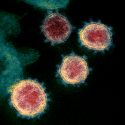COVID questions: Choosing a mask, food safety
Editor’s note: We will be publishing answers to questions about COVID-19 and the pandemic each week in this COVID questions column. If you have a question, please email it to covid19update@uc.wisc.edu.
Q: How do I find/identify a good washable cloth mask? How many layers of fabric are needed to be effective? Are there fabrics that are better than others? What type of filters are used in filter pockets? How many times can I wear a mask before washing?
A: Here are some suggestions that might help. Look for a mask that has a nose piece; the nose piece should hold its shape well. The mask should fit your face well and be comfortable. To improve fit, it can be helpful to try multiple mask styles and to modify the elastic or ties used to hold the mask in place.
One layer provides some effectiveness. More layers improves the filtration of the material, but reduces breathability. If breathability is low, more flow tends to go around the mask, which is generally bad. So fit becomes more important as the material becomes less breathable. The WHO recommends 3 layers: an internal layer of cotton or similar, a middle layer of a synthetic nonwoven or similar, and an outer layer is polyester or similar (https://apps.who.int/iris/rest/bitstreams/1279750/retrieve).
Some fabrics are better than others. As one example, the WHO has provided a ranked list of fabrics (https://apps.who.int/iris/rest/bitstreams/1279750/retrieve). Also, the following tests can help you evaluate fabrics: If you look at a light through the fabric, it is best if you can’t see bright spots. The more spots, and the larger the spots, the worse the material generally filters. Also, if you hold the fabric to your mouth, you should be able to breathe through it comfortably.
Filters are often synthetic nonwoven material such as spunbond polypropylene. If the filter has low breathability and covers only a portion of the mask, most of the flow will go around the filter; in this case the filter may not be helping or may not be helping much.
The WHO recommends washing a face mask when dirty, and also recommends washing daily (https://www.who.int/images/default-source/health-topics/coronavirus/clothing-masks-infographic—(web)-logo-who.png?sfvrsn=b15e3742_16)
– Scott Sanders, Professor Mechanical Engineering Department, Electrical and Computer Engineering Department, University of Wisconsin – Madison
Q: Do I still need to be worried about take-out food, groceries, etc.?
A: Please know that there is no evidence at this time that this virus can be transmitted through food. The primary route of transmission is person-to-person. Theoretically, a virus could be ‘picked up’ from a surface and then transferred through touching one’s eyes, nose or mouth; however, according to the CDC, this is not considered a primary route of transmission. My best advice is to follow the best food handling practices that are recommended any time: wash hands frequently and thoroughly, keep surfaces (especially food contact surfaces) clean, and cook food to the correct temperatures.
In the interest of public health, I would recommend watching for these things at restaurants:
- Making sure sick employees do not come to work.
- Making sure strict and frequent hand-washing is in place
- Making sure all staff are wearing appropriate masks all the time.
- Making sure that the restaurant is providing for and enforcing strict social distancing at all times.
- Checking to see if contact is minimized: touchless payment for example.
- Asking customers to refrain from coming if they have symptoms
- Making sure all customers are wearing masks except for when they are eating
I would check websites before ordering food to see what practices the restaurant is following. If in doubt, call the restaurant and ask. Minimally, the restaurant should be following local restrictions.
– Monica Theis, senior lecturer, Department of Food Science
See more answers to COVID questions at https://news.wisc.edu/tag/covid-questions/. Also, visit our COVID-19 impact site.
Tags: COVID questions, covid-19, health & medicine



